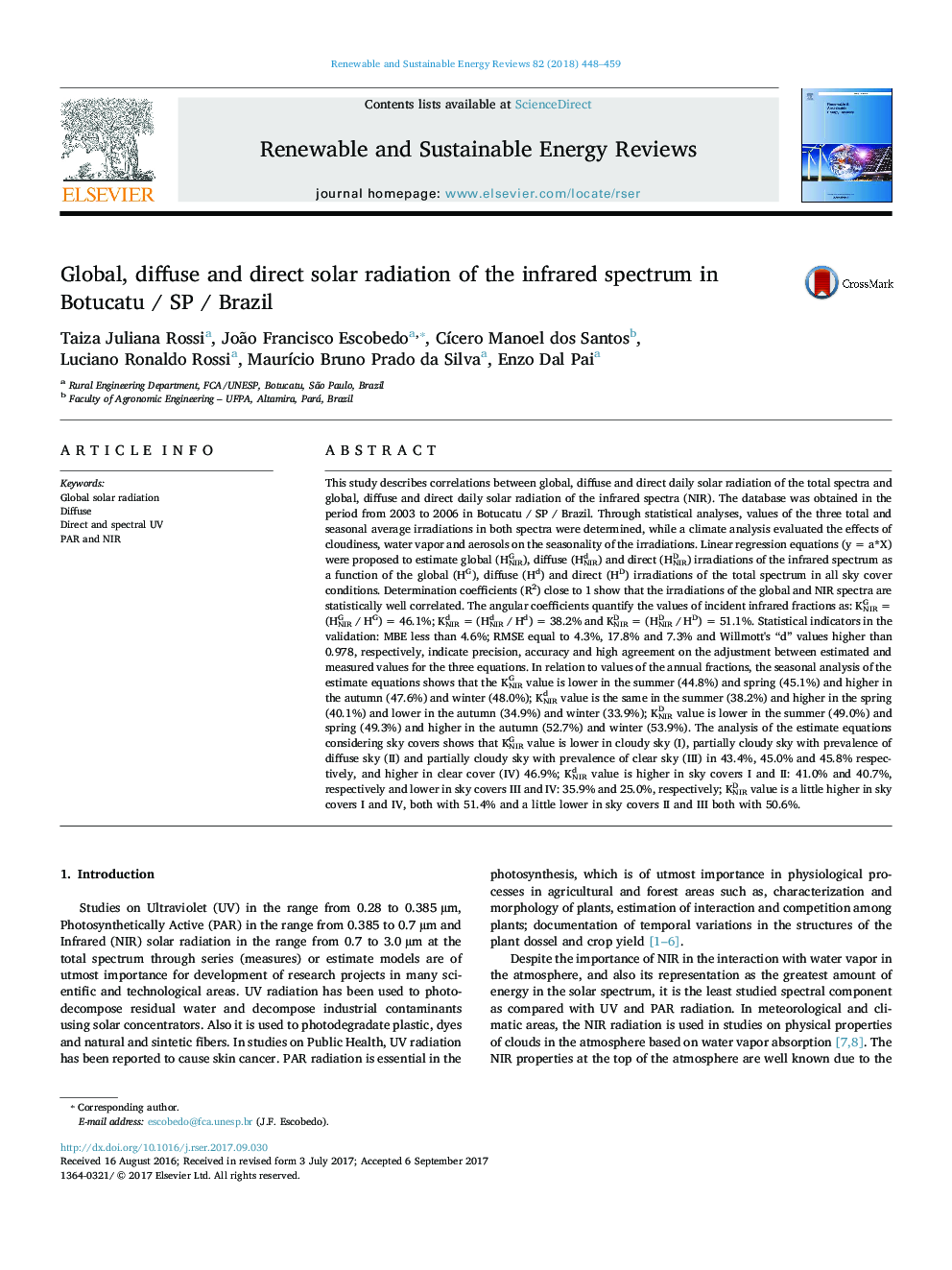| کد مقاله | کد نشریه | سال انتشار | مقاله انگلیسی | نسخه تمام متن |
|---|---|---|---|---|
| 5481880 | 1522304 | 2018 | 12 صفحه PDF | دانلود رایگان |
عنوان انگلیسی مقاله ISI
Global, diffuse and direct solar radiation of the infrared spectrum in Botucatu / SP / Brazil
دانلود مقاله + سفارش ترجمه
دانلود مقاله ISI انگلیسی
رایگان برای ایرانیان
موضوعات مرتبط
مهندسی و علوم پایه
مهندسی انرژی
انرژی های تجدید پذیر، توسعه پایدار و محیط زیست
پیش نمایش صفحه اول مقاله

چکیده انگلیسی
This study describes correlations between global, diffuse and direct daily solar radiation of the total spectra and global, diffuse and direct daily solar radiation of the infrared spectra (NIR). The database was obtained in the period from 2003 to 2006 in Botucatu / SP / Brazil. Through statistical analyses, values of the three total and seasonal average irradiations in both spectra were determined, while a climate analysis evaluated the effects of cloudiness, water vapor and aerosols on the seasonality of the irradiations. Linear regression equations (y = a*X) were proposed to estimate global (HGNIR), diffuse (HdNIR) and direct (HDNIR) irradiations of the infrared spectrum as a function of the global (HG), diffuse (Hd) and direct (HD) irradiations of the total spectrum in all sky cover conditions. Determination coefficients (R2) close to 1 show that the irradiations of the global and NIR spectra are statistically well correlated. The angular coefficients quantify the values of incident infrared fractions as: KGNIR = (HGNIR / HG) = 46.1%; KdNIR = (HdNIR / Hd) = 38.2% and KDNIR = (HDNIR / HD) = 51.1%. Statistical indicators in the validation: MBE less than 4.6%; RMSE equal to 4.3%, 17.8% and 7.3% and Willmott's “d” values higher than 0.978, respectively, indicate precision, accuracy and high agreement on the adjustment between estimated and measured values for the three equations. In relation to values of the annual fractions, the seasonal analysis of the estimate equations shows that the KGNIR value is lower in the summer (44.8%) and spring (45.1%) and higher in the autumn (47.6%) and winter (48.0%); KdNIR value is the same in the summer (38.2%) and higher in the spring (40.1%) and lower in the autumn (34.9%) and winter (33.9%); KDNIR value is lower in the summer (49.0%) and spring (49.3%) and higher in the autumn (52.7%) and winter (53.9%). The analysis of the estimate equations considering sky covers shows that KGNIR value is lower in cloudy sky (I), partially cloudy sky with prevalence of diffuse sky (II) and partially cloudy sky with prevalence of clear sky (III) in 43.4%, 45.0% and 45.8% respectively, and higher in clear cover (IV) 46.9%; KdNIR value is higher in sky covers I and II: 41.0% and 40.7%, respectively and lower in sky covers III and IV: 35.9% and 25.0%, respectively; KDNIR value is a little higher in sky covers I and IV, both with 51.4% and a little lower in sky covers II and III both with 50.6%.
ناشر
Database: Elsevier - ScienceDirect (ساینس دایرکت)
Journal: Renewable and Sustainable Energy Reviews - Volume 82, Part 1, February 2018, Pages 448-459
Journal: Renewable and Sustainable Energy Reviews - Volume 82, Part 1, February 2018, Pages 448-459
نویسندگان
Taiza Juliana Rossi, João Francisco Escobedo, CÃcero Manoel dos Santos, Luciano Ronaldo Rossi, MaurÃcio Bruno Prado da Silva, Enzo Dal Pai,